Swainson’s Hawk (Buteo swainsoni) is a majestic raptor renowned for its impressive soaring abilities and striking plumage.
Found in the Americas, this medium-sized bird of prey boasts a wingspan of 45 to 56 inches and exhibits a distinctive buteo shape.
Adult Swainson’s Hawks showcase a captivating mix of cinnamon-colored underparts, dark bibs, and patagial marks on their wings.
What sets them apart is their extraordinary long-distance migration, covering thousands of miles between North American breeding grounds and wintering areas in South America, primarily Argentina.
Their nomadic nesting behavior, a diverse diet comprising small mammals and birds, and unique vocalizations add to the allure of Swainson’s Hawk.
As a key player in maintaining ecosystem balance, understanding and preserving this species’ habitat and migration routes are crucial for appreciating and conserving the remarkable characteristics that define Swainson’s Hawk. Stay focused.
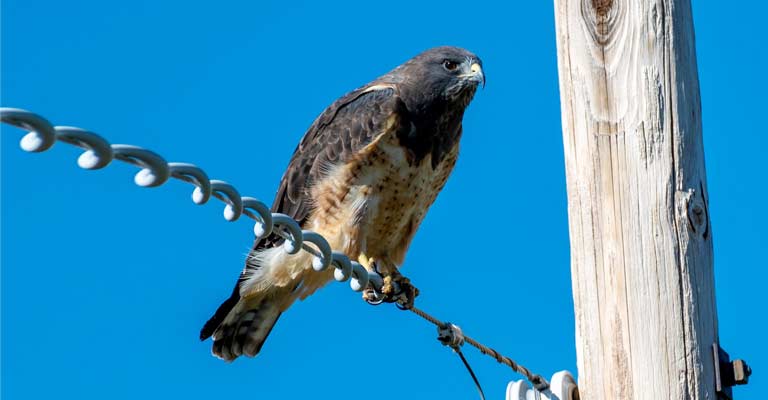
Identifying Characteristics of Swainson’s Hawk
Swainson’s Hawk (Buteo swainsoni) is a magnificent bird of prey known for its striking appearance and impressive soaring abilities.
Identifying this specific hawk requires careful observation of various characteristics that distinguish it from other raptors. Here are some key points to help you recognize Swainson’s Hawk in the wild.
Size and Shape
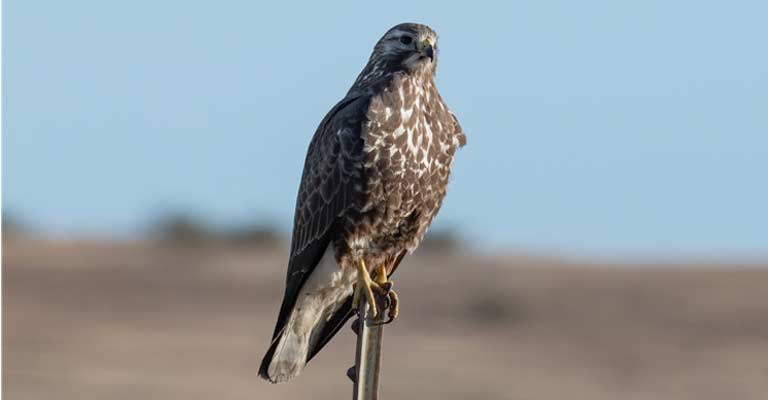
Swainson’s Hawk is a medium-sized raptor with a wingspan ranging from 45 to 56 inches.
It exhibits a classic buteo shape, characterized by broad, rounded wings and a relatively short, wide tail. Its streamlined body and powerful wings contribute to its exceptional soaring capabilities.
Coloration
The plumage of Swainson’s Hawk varies based on age and sex. Adult birds typically have a light underbelly with a cinnamon-colored wash on the breast and a distinct dark bib on the throat.
Their upperparts are dark brown, and the wings often display a contrasting light patch known as a patagial mark. Immature Swainson’s Hawks have a more mottled appearance, featuring a mix of light and dark feathers.
Head and Facial Features
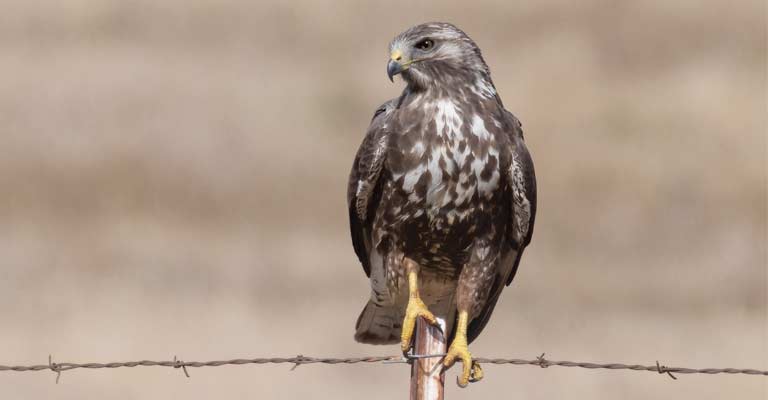
The head of Swainson’s Hawk is relatively small compared to its body, and it sports a distinctive white eyebrow or supercilium.
The eyes are large and bright yellow, and the hooked beak is dark and sharp. These features, combined with the white throat, contribute to a distinctive facial pattern.
Flight Style
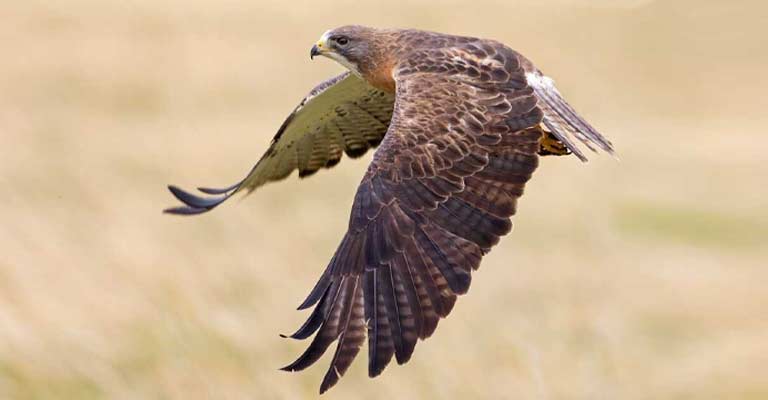
One of the most remarkable characteristics of Swainson’s Hawk is its soaring flight. It is often seen riding thermals or soaring in wide circles.
The wings are held in a dihedral shape, forming a shallow V, and the bird displays effortless gliding with minimal wing flapping.
Tail
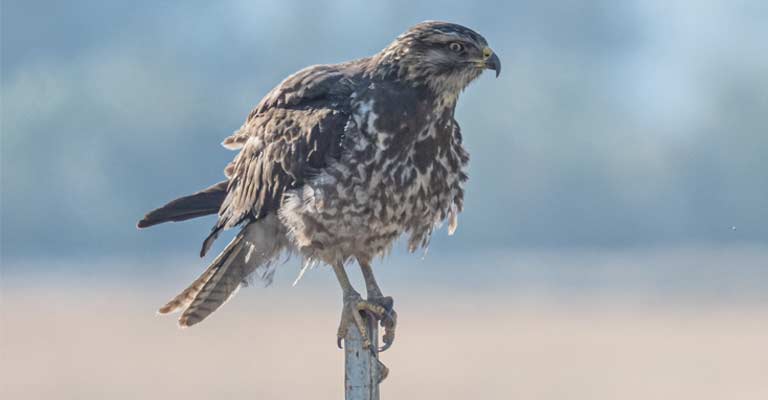
The tail of Swainson’s Hawk is short and squared-off, which distinguishes it from other hawks with longer, more tapered tails.
This feature is particularly noticeable during flight and aids in differentiating Swainson’s Hawk from other raptor species.
Habitat and Migration
Swainson’s Hawks have an extensive migration range, breeding in North America and wintering in South America.
During migration, large flocks can be seen soaring together in a characteristic kettle, creating a spectacular sight in the sky.
Vocalizations
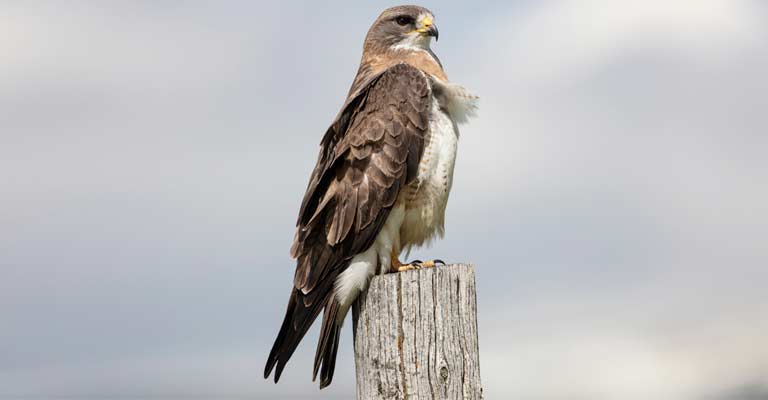
While not as vocal as some other raptors, Swainson’s Hawks produce distinct calls.
The typical call is a high-pitched, whistled scream that can be heard during flight or when perched. Familiarizing yourself with these vocalizations can aid in identification.
Behavior
Swainson’s Hawks often exhibit behavior such as hovering while hunting, especially when searching for prey in open grasslands.
They primarily feed on small mammals and birds, and their hunting style involves a combination of soaring and swooping down to catch prey.
Recognizing Swainson’s Hawk involves a combination of size, coloration, flight characteristics, and behavior.
Developing a keen eye for these details will enhance your ability to identify this remarkable bird of prey in its natural habitat.
Taxonomy of Swainson’s Hawk
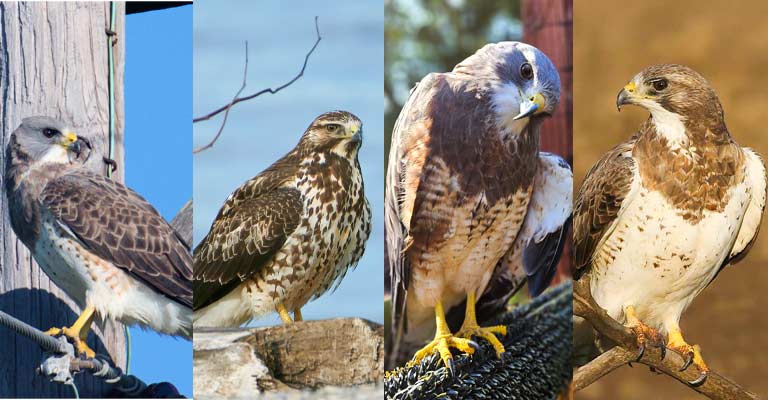
Here is a table detailing the taxonomy of Swainson’s Hawk:
| Taxonomic Level | Classification |
| Domain | Eukaryota |
| Kingdom | Animalia |
| Phylum | Chordata |
| Class | Aves |
| Order | Accipitriformes |
| Family | Accipitridae |
| Genus | Buteo |
| Species | B. swainsoni |
This table provides a hierarchical overview of the taxonomic classification of Swainson’s Hawk, from the broad domain level down to the specific species.
Each level represents a distinct category in the biological classification system, outlining the evolutionary relationships and shared characteristics of this magnificent bird within the broader context of life on Earth.
Swainson’s Hawk (Buteo swainsoni) belongs to the Animalia kingdom, Chordata phylum, and Aves class. It is classified under the order Accipitriformes and the family Accipitridae.
Within the Accipitridae family, Swainson’s Hawk is specifically identified in the Buteo genus. The species’ name is B. swainsoni.
This raptor’s taxonomy signifies its place in the broader context of the animal kingdom, highlighting its avian nature, relationship to other hawks, and the specific genus and species that distinguish it within the diverse world of birds.
Swainson’s Hawk Life History
Swainson’s Hawk (Buteo swainsoni) is a fascinating raptor species with a rich life history that spans breeding grounds in North America and wintering territories in South America.
Understanding the various aspects of its life history provides valuable insights into the ecological role and conservation needs of this remarkable bird.
Food
Swainson’s Hawks are opportunistic hunters with a diverse diet. Their primary food sources include small mammals such as rodents, birds, reptiles, and large insects.
During the breeding season, they often hunt in pairs or small groups, utilizing their soaring flight to locate prey in open grasslands and agricultural fields.
Habitat
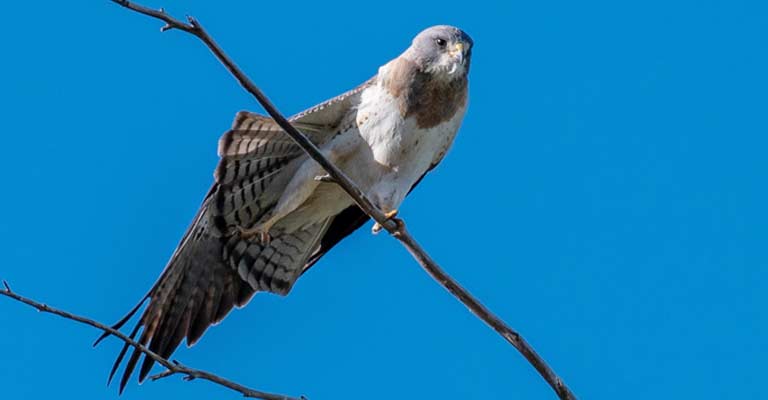
These hawks exhibit a preference for open habitats, including grasslands, prairies, and agricultural areas.
They are commonly found nesting in trees along watercourses, but they also adapt well to human-altered landscapes.
Swainson’s Hawks are known for their impressive long-distance migrations, covering thousands of miles between their breeding and wintering grounds.
Range Map
The breeding range of Swainson’s Hawks extends from central Alaska and Canada to the southern United States, while their wintering grounds include South America, primarily in Argentina.
The species’ migratory behavior is a critical aspect of its life history, reflecting its dependence on different ecosystems throughout the year.
Nesting
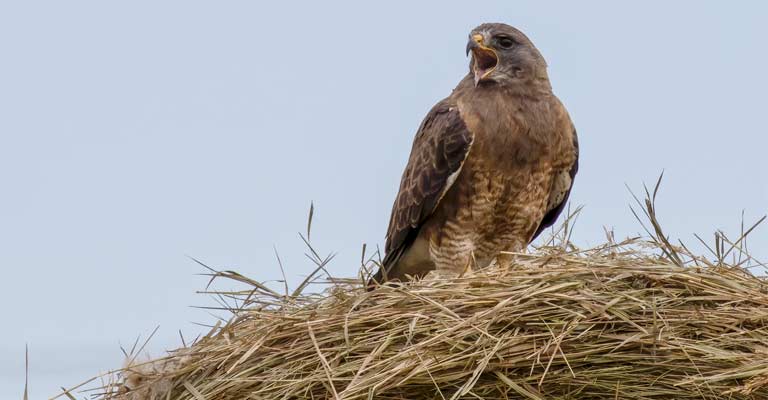
Swainson’s Hawks build large nests, often using existing structures such as trees or artificial platforms. The nests are constructed with sticks and lined with softer materials.
Mated pairs return to the same nesting sites year after year, contributing to a strong sense of fidelity to their breeding grounds.
Here’s a table summarizing nesting details of Swainson’s Hawk:
| Nesting Details | Facts |
| Clutch Size | 1 to 5 eggs |
| Number of Broods | Usually 1 per breeding season |
| Egg Length | Approximately 2.2 to 2.8 inches (5.6 to 7.1 cm) |
| Egg Width | Approximately 1.8 to 2.1 inches (4.6 to 5.3 cm) |
| Incubation Period | About 28 to 32 days |
| Nestling Period | Approximately 35 to 40 days |
| Egg Description | Typically pale blue or greenish, sometimes with speckles |
| Nest Location | Trees, often near watercourses; also on artificial structures |
| Nest Construction | Sticks lined with softer materials |
| Parental Involvement | Both parents participate in incubation and care for the chicks |
| Nest Reuse | Mated pairs often return to the same nesting sites |
These details provide a comprehensive overview of the nesting habits of Swainson’s Hawk, emphasizing their breeding behaviors, nesting locations, and the roles of the parents in caring for their eggs and chicks.
Breeding
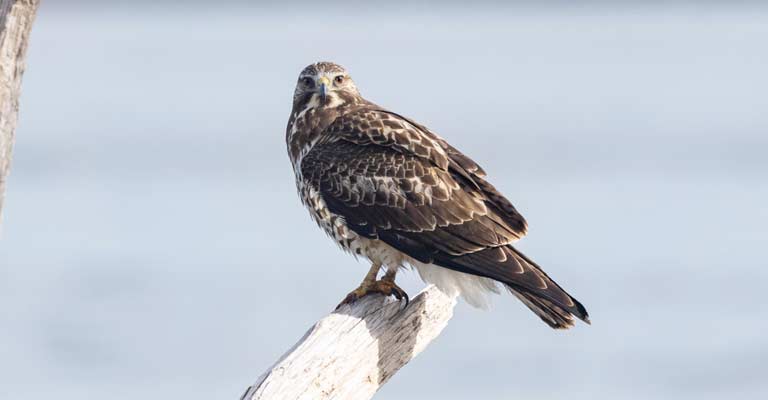
Breeding season for Swainson’s Hawks typically begins in late spring. Males engage in impressive courtship displays, including soaring and diving maneuvers.
Once a pair forms a bond, they collaborate in nest-building and raising their young. The female lays one to five eggs, and both parents participate in incubation and caring for the chicks.
Diseases
Like many bird species, Swainson’s Hawks can be susceptible to various diseases.
Avian pox, West Nile virus, and lead poisoning are among the threats they face. These diseases can impact the health and reproductive success of individuals and populations.
Treatment
Conservation efforts often include monitoring for diseases and implementing measures to mitigate their impact.
Rehabilitation centers may play a role in treating injured or sick Swainson’s Hawks, with a focus on providing medical care and, if possible, releasing them back into the wild.
Conservation
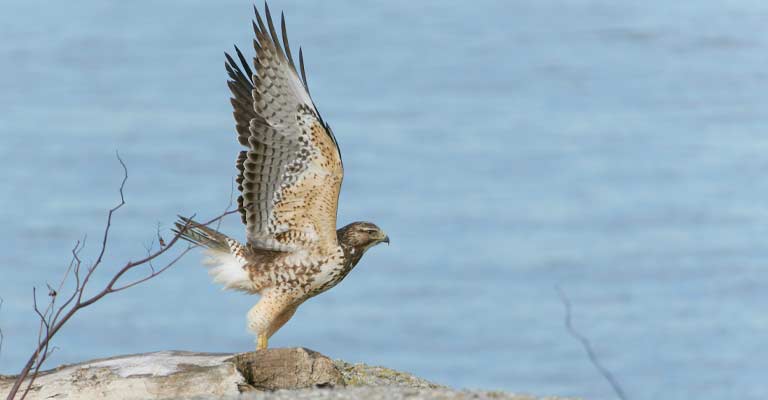
The conservation status of Swainson’s Hawks varies across their range.
While the species is not currently globally threatened, certain populations face localized threats due to habitat loss, pesticide exposure, and other human-related factors.
Conservation initiatives aim to protect critical habitats, reduce pesticide use, and promote awareness to ensure the long-term survival of this species.
Swainson’s Hawk’s life history is a testament to its adaptability and the interconnectedness of ecosystems across its vast range.
Conservation efforts that consider their diverse needs, from breeding to wintering grounds, are essential for sustaining healthy populations of this majestic bird.
10 Amazing Facts About Swainson’s Hawk
Swainson’s Hawk (Buteo swainsoni) is a captivating raptor species with a range of fascinating features and behaviors. Here are 10 amazing facts about Swainson’s Hawk:
- Incredible Migration: Swainson’s Hawks undertake one of the longest migrations of any North American raptor. They travel thousands of miles from their breeding grounds in North America to wintering areas in South America, primarily Argentina. This remarkable journey showcases their endurance and navigational skills.
- Distinctive Plumage: Adult Swainson’s Hawks exhibit a striking plumage with a cinnamon wash on the breast and a dark bib on the throat. Their upperparts are dark brown, and they often display a notable light patch on the wings known as a patagial mark.
- Long Lifespan: Swainson’s Hawks can have a relatively long lifespan, with some individuals living up to 15 years or more. Their ability to adapt to diverse habitats and navigate extensive migratory routes contributes to their survival.
- Soaring Masters: These hawks are renowned for their exceptional soaring abilities. They utilize thermals and updrafts to cover vast distances during migration, often soaring in graceful circles with minimal wing flapping.
- Nomadic Nesting: Swainson’s Hawks are known for their flexibility in choosing nesting locations. While they typically nest in trees along watercourses, they readily adapt to human-altered landscapes, using artificial structures such as utility poles and even haystacks.
- Diet Diversity: Swainson’s Hawks have a diverse diet, preying on small mammals, birds, reptiles, and large insects. During the breeding season, they engage in cooperative hunting, demonstrating effective teamwork in securing food for their young.
- Distinctive Vocalizations: While not as vocal as some other raptor species, Swainson’s Hawks produce unique calls. Their vocalizations include high-pitched, whistled screams that are often heard during flight or when perched.
- Migratory Kettles: During migration, Swainson’s Hawks often form large groups called kettles. These swirling masses of hawks riding thermals create breathtaking aerial displays as they journey across the sky.
- Conservation Significance: Swainson’s Hawks play a crucial role in maintaining ecosystem balance by controlling rodent populations. Conservation efforts focus on preserving their diverse habitats and ensuring the sustainability of their migration routes.
- Population Variability: The conservation status of Swainson’s Hawks varies across their range. While some populations are stable, others face localized threats, emphasizing the need for targeted conservation measures to ensure the well-being of this remarkable species.
Swainson’s Hawk stands out not only for its impressive physical features but also for its remarkable behaviors, making it a species of great ecological importance and conservation interest.
Wrapping Up
Swainson’s Hawk stands as a testament to nature’s wonders, embodying adaptability, resilience, and migratory marvels.
Its distinctive features, from striking plumage to cooperative hunting, underscore the importance of understanding and conserving this remarkable raptor.
As we delve into its life history and nesting habits, we gain not only a deeper appreciation for the species but also insights into the delicate balance of ecosystems it influences.
The challenges faced by Swainson’s Hawks emphasize the urgency of conservation efforts to safeguard their habitats and migration routes, ensuring these magnificent birds continue to grace our skies for generations to come. Best of luck.
